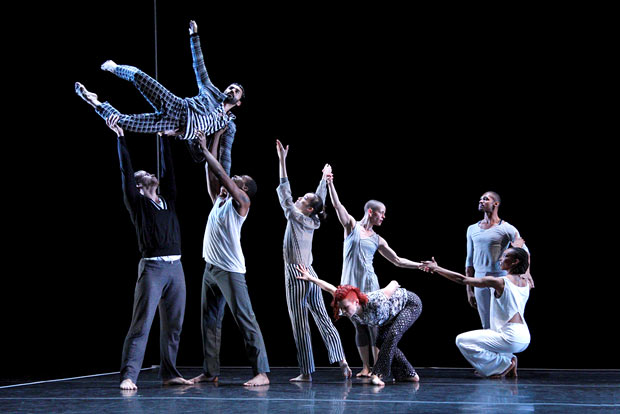
© Paul B. Goode. (Click image for larger version)
Bill T. Jones / Arne Zane Dance Company
(With the Orion String Quartet)
Play and Play: Ravel: Landscape or Portrait?, Story/
New York, Joyce Theatre
27 March 2013
About Bill T Jones
www.joyce.org
www.orionquartet.com
Bill T. Jones and Co. Take on the Canon
It takes a certain amount of nerve to build a dance season around some of the great masterpieces of the chamber music repertoire. It’s not simply a matter of status in the musical canon; these pieces are strong, they produce emotions, they command attention for themselves. But Bill T Jones is not a timid artist. So he’s taken the plunge, in collaboration with the excellent (and quite willing) musicians of the Orion String Quartet. Every piece in this thirtieth-anniversary season – two programs, billed under the header “Play and Play” – is set to “important” chamber music (Mozart, Beethoven, Mendessohn, Schubert, etc.). It’s exciting to see and hear such music at the Joyce. So much so, in fact, that at times the sheer voluptuousness of the sound (and its reverberations in one’s gut) threatens to overwhelm the activity of the dancers. I’ll admit that there were moments last night when I closed my eyes, in response to an almost physical need to let the music completely engulf my senses. There was simply no space for anything else. (The works performed last night, Ravel: Landscape or Portrait? and Story, were both New York premières, created in the last twelve months. The first was set to Ravel’s String Quartet in F Major, the second to no less than Schubert’s Death and the Maiden.)
And yet, Mr. Jones holds his own, in part by not attempting to follow the music in any literal way. The choreography, which is described in the program as being made in collaboration with Janet Wong (Associate Artistic Director) and the dancers, has a pleasingly free, earthy, all-over-the-place quality. Each dancer has a story to tell and is allowed to do so; the stories, in turn, are artfully subdivided into smaller units (phrases) and re-distributed across the stage, thereby becoming themes, patterns, motifs. (This use of short phrases to suggest larger narratives, the plot of which we cannot hope to understand, reminded me of Balanchine’s Episodes.) One dancer begins a series of adjustments involving perhaps the arms, torso, and head; another joins in, and then two more, or three or four. The repeated phrases act as signposts, giving a sense of structure, much as the repeats do in a piece of music. But Jones’ structure does not correspond to Ravel’s or Schubert’s, though at times it seems to echo it. This is neither “music visualization” nor, what is worse, the indulgent use of “deep” music as aural wallpaper. There is form, there is feeling. And, because Jones is interested in stories, there is a sense of individual expression and eccentricity, embedded within a larger superstructure.
The wild array of body shapes and temperaments within the company is striking. This is certainly one of the most diverse ensembles around, and that goes for both uptown and downtown dance. Similarly the partnering, for the most part, is free of gender clichés; women handle men, men handle men, women handle women. In this, and in the mostly pedestrian quality of the movement Jones tends to use, one senses the influence of Trisha Brown. (Where does one not sense the influence of Trisha Brown?) At the same time Jones seems to be more interested showmanship than she, and in jagged contrasts of accentuation. Brown is also an imaginative organizer of activity. The number of dancers involved in an action is constantly changing. The frame of the stage is blurred, with people lingering, watching, or disappearing into the wings. For Ravel: Landscape or Portrait?, he has created a stage within the stage by roping off a cube just a few feet from the wings and the edge of the proscenium. Dancers pause, either within or outside of the cube, in sculptural groups, as if someone had hit the pause button. We see them at play and in repose; it’s artificial but beautiful.

© Paul B. Goode. (Click image for larger version)
But what one feels most strongly is the keen attention payed to the one over the many. Uniformity does not exist in Jones’s world. In Ravel, the experience of the individual within the group becomes the overriding theme. The focus here is on Erick Montes Chavero, a small, faun-like dancer with liquid arms and darting feet. He is both part of the community onstage and external to it, driven by a metabolism that runs at double-speed, arms flowing from his back like swan wings, or swiveling on deeply-bent legs. Chains form and break apart, clusters assemble and dissolve, and through it all Chavero seems to burn with a desire to lead, to follow, to be his own man, but also to be embraced by his fellow travelers. The fin-de-siècle frolicsomeness and ardor of Ravel finds some echo in this restless soul.
I took the subtitle of the work (Landscape or Portrait?) to be a referrence to this alternation between group formations and the lone figure. It turns out that it actually describes a formal element: there exist two different versions of the third movement of Ravel, one of which is selected through “chance procedures” (like tossing a coin) before each performance. Since the audience isn’t aware of which version it is seeing, this fact is mainly interesting to the dancers. Last night, it turns out, the company performed the “landscape” version, though I only found this out later, after making inquiries. Knowing this did not change my experience of the piece. For the past two seasons, Jones has been playing around with chance procedures and “indeterminacy,” a concept developed by John Cage, in which the structure of a work is flexible and therefore open to lucky coincidence. This “open” structure is more apparent in the second work on the program, Story/, set to Death and the Maiden. As the program explains, a series of movements are developed by the dancers, then offered as a “menu” of options. These in turn are laid over the music. They are not meant to make any reference to the music, only to coexist with it in time. (This is a conscious tribute to Merce Cunningham’s working methods, by the way.) Jones first used this approach last year in Story/Time; in that work, the choreographer read one-minute stories (in the manner of John Cage) while his dancers performed the phrases they had developed. Funny/odd resonances resulted.

© Paul B. Goode. (Click image for larger version)
In Story/, Jones’s one-minute stories are replaced with Schubert’s quartet. According to Jones, “the movement meets the music thus crafting a lively conversation.” Conceptually, it’s intriguing, but in practice, the “heat” of the music rather overpowers the “coolness” of the actions, at least for this listener. Jones is aware of this danger and attempts to break the music’s spell with vocalizations by the dancers: “Hey!” they cry out, or they stomp and clap their hands. He also introduces green apples to be tossed, held, rolled across the stage. Nevertheless, the dancers’ activities never quite rise to the level of the towering emotionality of the music. The sounds – stomping, chanting – don’t really compete, they merely end up feeling superfluous. This is, after all, the work that Schubert composed as he lay dying. Each variation in the second movement has the monumental weight of a final message to the world.
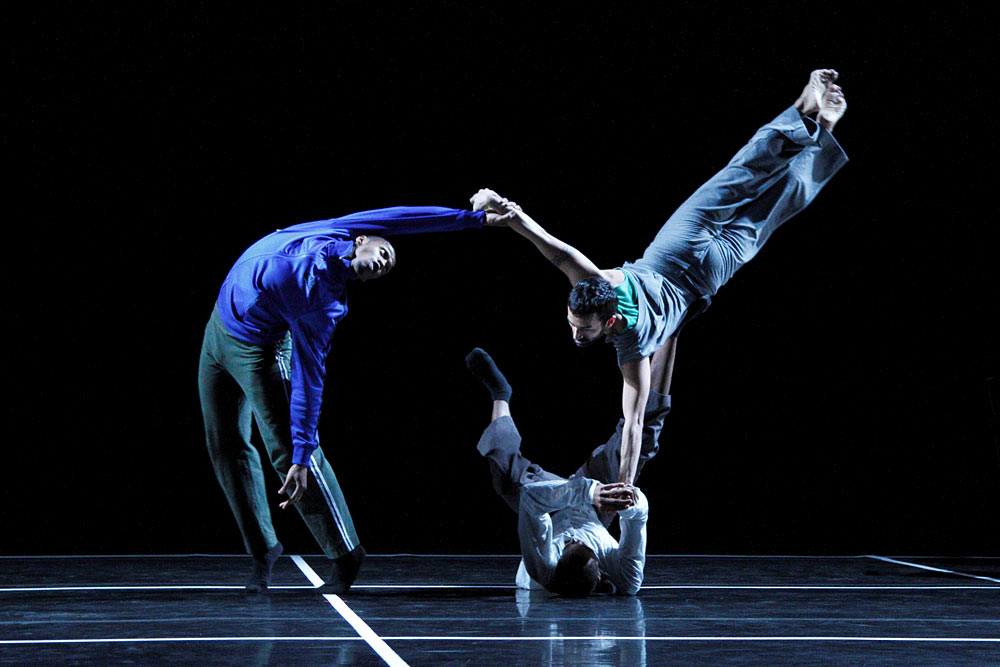
© Paul B. Goode. (Click image for larger version)
And yet the dance is never less than compelling. Two dancers act out a formal scene, lifting their fingers as if to make a point; two others play what looks like a game of rock-paper-scissors. The dancers advance in a formation that looks like the prow of a ship. Three men fly in capeoira-like flip-jumps; then a woman joins in. Chains are formed, twist, break apart. And there is a particularly strong duet for tall, delicate LaMichael Leonard and Jennifer Nugent, a dancer both powerfully muscular and emotionally raw. They roll on the ground; he pulls her by one foot, they embrace, he balances on her back, she flips him over, he puts his hand on her cheek. The struggle is both formal – how do I get you from here to there? – and dramatically human. Like Jones’ treatment of the great music of the classical music canon, it is a conversation. And one without a foregone conclusion.













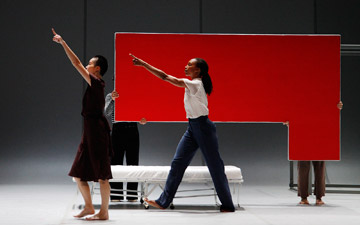
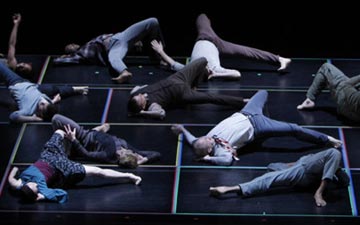
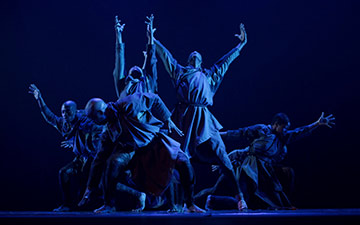

[…] Here is my review of the program of new works by Bill T Jones at the Joyce, in the company’s thirtieth anniversary season. Both works are set to “important” chamber music (Ravel’s String Quartet in F Major and Schubert’s Death and the Maiden), performed here by the excellent Orion String Quartet. […]
Marina!
What a splendid review. Made little pings! go off in my head. For example, I love your insight about “landscape” and “portrait” as group and one. And I like your reminder that Jones really does achieve a democracy of bodies and that the dancers move like themselves. You’re right that choreographers, even downtown ones, tend to gravitate toward particular kinds of movers. Jones is rare in his eclecticism and yet it doesn’t feel forced. It feels like an embodiment of the way he thinks. Also, I’m glad you singled out the sprite Eric Montes Chavero. With each season, I love him more and more. You made me want to run to see this second programme–esp. the Ravel. I’m glad the company has two weeks at the Joyce. I’m interested to see the procedural experiments
~) Apollinaire